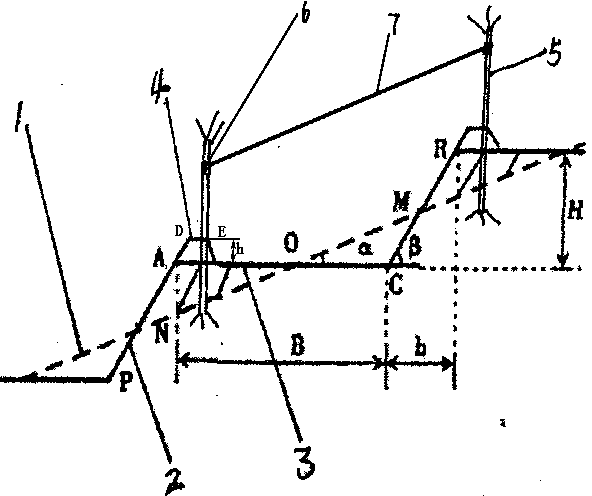A kind of cultivation method of kiwifruit
A cultivation method and kiwifruit technology, applied in the field of kiwifruit planting, can solve problems such as poor wind resistance, difficult cement columns, occupation of basic farmland, etc., and achieve the effects of reducing top column input, good wind resistance, and avoiding damage
- Summary
- Abstract
- Description
- Claims
- Application Information
AI Technical Summary
Problems solved by technology
Method used
Image
Examples
Embodiment 1
[0030] A kind of cultivation method of kiwifruit, the kiwifruit varieties that adopt are Xuxiang and Ruanzao, comprising the following steps:
[0031] (1) Garden construction: including the positioning of the top pillar and the reconstruction of horizontal terraces. The top pillar is positioned as: in the sunny slope forest area with a slope of ≤ 25°, the tree is used as the top pillar, and shrubs and weeds are removed. Arbors are positioned in the north-south and east-west directions as the top pillars of the kiwifruit scaffolding, and the insufficient top pillars are filled by replanting trees; wherein, the trees are ginkgo biloba; in order to control soil erosion and facilitate water and fertilizer management, the forest area needs Carry out the transformation of horizontal terraced fields, the transformation of said horizontal terraced fields is the transformation of sunny slope terraced fields. In this embodiment, the slope α≤25° in the mountain forest area, the height H o...
Embodiment 2
[0037] A kind of cultivation method of kiwifruit, the kiwifruit varieties that adopt are Xuxiang and Ruanzao, comprising the following steps:
[0038] (1) Garden construction: including the positioning of the top pillar and the reconstruction of horizontal terraces. The top pillar is positioned as: in the shady mountain forest area with a slope ≤ 15°, with trees as the top pillar, shrubs and weeds are removed, and the area is 6m×6m The north-south and east-west directions are positioned to leave arbors as the top pillars of the kiwifruit scaffolding, and the insufficient top pillars are filled by replanting trees; wherein, the arbors are poplars; in order to control soil erosion and facilitate water and fertilizer management. To carry out the transformation of the horizontal terraces, the transformation of the horizontal terraces is the transformation of the shady terraces. In this embodiment, in the transformation of the shady slopes with a slope≤15°, the height H of the shady...
PUM
 Login to View More
Login to View More Abstract
Description
Claims
Application Information
 Login to View More
Login to View More - R&D
- Intellectual Property
- Life Sciences
- Materials
- Tech Scout
- Unparalleled Data Quality
- Higher Quality Content
- 60% Fewer Hallucinations
Browse by: Latest US Patents, China's latest patents, Technical Efficacy Thesaurus, Application Domain, Technology Topic, Popular Technical Reports.
© 2025 PatSnap. All rights reserved.Legal|Privacy policy|Modern Slavery Act Transparency Statement|Sitemap|About US| Contact US: help@patsnap.com


